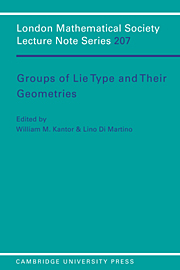Book contents
- Frontmatter
- Contents
- Preface
- List of talks
- List of participants
- Representations of groups on finite simplicial complexes
- Coxeter groups and matroids
- Finite groups and geometries: A view on the present state and on the future
- Groups acting simply transitively on the vertices of a building of type Ãn
- Finite simple subgroups of semisimple complex Lie groups – a survey
- Flag-transitive extensions of buildings of type G2 and C3*
- Disconnected linear groups and restrictions of representations
- Products of conjugacy classes in algebraic groups and generators of dense subgroups
- Monodromy groups of polynomials
- Subgroups of exceptional algebraic groups
- The geometry of traces in Ree octagons
- Small rank exceptional Hurwitz groups
- The direct sum problem for chamber systems
- Embeddings and hyperplanes of Lie incidence geometries
- Intermediate subgroups in Chevalley groups
- On a certain class of Frattini extensions of finite Chevalley groups
- Economical generating sets for finite simple groups
Disconnected linear groups and restrictions of representations
Published online by Cambridge University Press: 06 January 2010
- Frontmatter
- Contents
- Preface
- List of talks
- List of participants
- Representations of groups on finite simplicial complexes
- Coxeter groups and matroids
- Finite groups and geometries: A view on the present state and on the future
- Groups acting simply transitively on the vertices of a building of type Ãn
- Finite simple subgroups of semisimple complex Lie groups – a survey
- Flag-transitive extensions of buildings of type G2 and C3*
- Disconnected linear groups and restrictions of representations
- Products of conjugacy classes in algebraic groups and generators of dense subgroups
- Monodromy groups of polynomials
- Subgroups of exceptional algebraic groups
- The geometry of traces in Ree octagons
- Small rank exceptional Hurwitz groups
- The direct sum problem for chamber systems
- Embeddings and hyperplanes of Lie incidence geometries
- Intermediate subgroups in Chevalley groups
- On a certain class of Frattini extensions of finite Chevalley groups
- Economical generating sets for finite simple groups
Summary
INTRODUCTION
In, Dynkin, Seitz and Testerman classified the maximal closed connected subgroups of the simple algebraic groups over an algebraically closed field K of characteristic p ≥ 0. The hard part of their analyses, for subgroups of the groups of classical type, concerns an irreducible, closed, connected subgroup G of SL(V) for some K-vector space V. They determine explicitly all possibilities for closed connected overgroups Y of G in I(V) (where I(V) = SL(V), SO(V), or Sp(V) depending upon the form on V preserved by G); the results appear in tables giving the high weights of the modules V|G and V|Y.
The question of inclusion relations among irreducible subgroups of SL(V), in addition to having implications for the subgroup structures of classical groups, is of interest in its own right. In this paper we present some recent results concerning this question when we allow subgroups that are not connected (the full proofs may be found in). Specifically, in Sections 2 and 3 we discuss the structure and some of the methods of the proof of Theorem 1. Let G be a non-connected algebraic group with simple identity component X. Let V be an irreducible KG-module with restricted X-high. weight(s).
- Type
- Chapter
- Information
- Groups of Lie Type and their Geometries , pp. 111 - 116Publisher: Cambridge University PressPrint publication year: 1995



